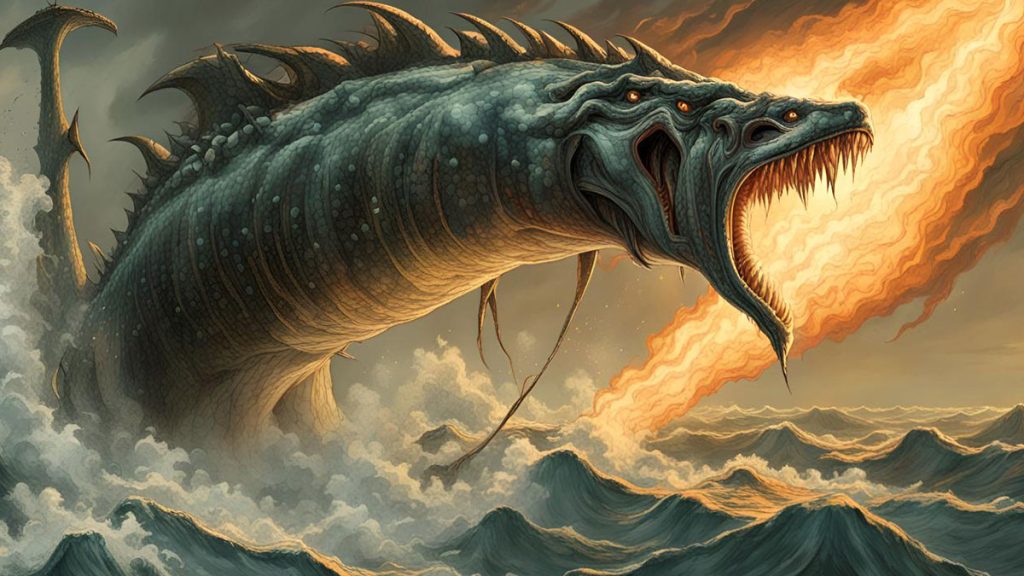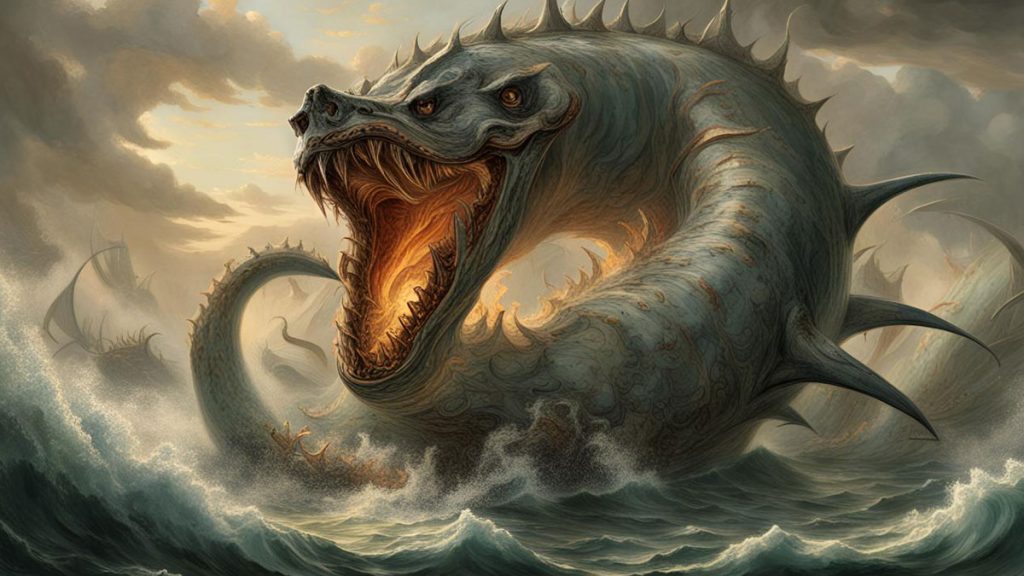The Leviathan is a mythical primordial sea monster mainly prevalent in Jewish religious texts but also found in early Christian writings. The creature may have its origin in prebiblical myths about giant sea creatures from Mesopotamia.
The Leviathan appears in three books of the Hebrew Bible and the Christian Old Testament. It is usually described as a sea monster, serpent, or even a dragon. It is a powerful, untameable beast with vicious teeth and impenetrable scale-like armor. It breathes fire and can churn up the seas in a great tumult, meaning it’s not an animal one would wish to encounter.
The water-dwelling monster is usually referenced alongside the Behemoth, another fearsome primordial beast. Both creatures were first mentioned in the Book of Job from the Old Testament. While the Leviathan is considered a beast of the water, Behemoth is king of the land. A third primordial beast, Ziz, bosses the skies.
The Leviathan is described in detail in the Book of Job
The Behemoth features in a few verses of Job chapter 40, but the whole of chapter 41 is dedicated to the Leviathan. The creature is described as a fearsome beast with skin like “barbed irons” and nostrils that spew smoke like a “seething pot or caldron.” Chapter 41 introduces the Leviathan as follows:
“Canst thou draw out leviathan with an hook? or his tongue with a cord which thou lettest down? Canst thou put an hook into his nose? or bore his jaw through with a thorn?…. Canst thou fill his skin with barbed irons? or his head with fish spears? Lay thine hand upon him, remember the battle, do no more. Behold, the hope of him is in vain: shall not one be cast down even at the sight of him? None is so fierce that dare stir him up: who then is able to stand before me?”
The chapter continues to describe a diabolical beast, focusing heavily on its fire-breathing qualities and impenetrable scales, which have led later writers to wonder if it’s actually a dragon.
“Who can open the doors of his face? his teeth are terrible round about…. His scales are his pride, shut up together as with a close seal….. Out of his mouth go burning lamps, and sparks of fire leap out. Out of his nostrils goeth smoke, as out of a seething pot or caldron. His breath kindleth coals, and a flame goeth out of his mouth. The flakes of his flesh are joined together: they are firm in themselves; they cannot be moved. His heart is as firm as a stone; yea, as hard as a piece of the nether millstone.”

The rest of the chapter stresses how the Leviathan is impervious to weapons. Conventional weapons such as spears, darts, and swords are useless against it. In fact, the animal “laugheth at the shaking of a spear” and treats “iron as straw” and “brass as rotten wood.”
Leviathan featured in multiple Biblical books and religious texts
Unlike the Behemoth, the Leviathan makes more appearances in the Bible. In the Book of Psalms, the Leviathan is a multi-headed serpent God created to “frolic” in the seas. God kills the beast and then serves it to the Hebrews in the desert. In the Book of Isaiah, the Leviathan is described as a “gliding” and “coiling” serpent of the deep.

The Leviathan and the Behemoth also appear in end-of-days apocryphal religious texts such as the Book of Enoch, which is rejected as part of the Biblical canon by both Jewish and Christian mainstream denominations. These later texts commonly suggest that the two primordial beasts will be slaughtered and eaten during the apocalypse or second coming. According to one interpretation of the Jewish Talmud, God created the Leviathan on the fifth day, and initially, there were two, a male and a female. However, God became concerned that the creatures would multiply and destroy the world, so he killed the female. The poor creature’s flesh was retained to be eaten by the righteous on the advent of the Messiah.
Does the Leviathan originate in ancient Mesopotamia?
Mythical sea creatures are a common feature in ancient cultures worldwide. A standard theory states that the concept of the Leviathan may have first come from the Ugaritic myth of Baal. A series of texts from the ancient Syrian port of Ugarit, written about 1500–1300 BCE, detail the adventures of the Canaanite God Baal, who entered into a battle with a terrifying sea creature called Yammu. Some authors have speculated that Yammu may have been a direct inspiration for the Leviathan.
There are also theories that the Leviathan may have been a real creature, such as a crocodile, albeit with grossly exaggerated characteristics. Other theories suggest that the sea monster may have been a live dinosaur or the fossilized remains of an ancient real creature. However, it is most likely the Levaithan is purely mythological.
References
BibleGateway.com, “Job 41,” and “Psalm 104: 26,” in New International Version, accessed July 1, 2024.
Britannica.com “Leviathan,” accessed June 27, 2024.
Bolinger, Hope. “What Is the Leviathan According to the Bible?” in Christianity.com, accessed June 27, 2024.
FairytalesAndMyths.com, “Behemoth,” accessed July 1, 2024.
Hirsch, Emil. Kohler, Kaufmann. Schechter, Solomon. Broydé, Isaac. “Leviathan and Behemoth,” in JewishEncyclopedia.com, accessed June 27, 2024.
Jarrett, Ed. “Leviathan and Behemoth in the Bible: Real or Myth?” in BibleStudyTools.com, accessed June 27, 2024.
Pelaia, Ariela. “Leviathan in Jewish Legend and the Bible,” in LearnReligions.com, accessed July 1, 2024.
